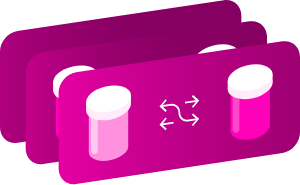This drug entry is astuband has not been fully annotated. It is scheduled to be annotated soon.
识别
- 总的来说ic Name
- Fluindione
- DrugBank Accession Number
- DB13136
- Background
-
Fluindione is under investigation for the treatment of Venous Thrombosis, Pulmonary Embolism, Permanent Atrial Fibrillation, and Anticoagulating Treatment on a Duration at Least 12-month-old Superior. Fluindione has been investigated for the treatment of Blood Coagulation Disorders.
- Type
- Small Molecule
- Groups
- Approved, Investigational
- Structure
- Weight
-
Average: 240.233
Monoisotopic: 240.058657693 - Chemical Formula
- C15H9FO2
- Synonyms
-
- Fluindione
Pharmacology
- Indication
-
Not Available
 Reduce drug development failure ratesBuild, train, & validate machine-learning models
Reduce drug development failure ratesBuild, train, & validate machine-learning models
with evidence-based and structured datasets.Build, train, & validate predictive machine-learning models with structured datasets. - Contraindications & Blackbox Warnings
-
 Avoid life-threatening adverse drug eventsImprove clinical decision support with information oncontraindications & blackbox warnings, population restrictions, harmful risks, & more.Avoid life-threatening adverse drug events & improve clinical decision support.
Avoid life-threatening adverse drug eventsImprove clinical decision support with information oncontraindications & blackbox warnings, population restrictions, harmful risks, & more.Avoid life-threatening adverse drug events & improve clinical decision support. - Pharmacodynamics
-
Not Available
- Mechanism of action
- Not Available
- Absorption
-
Not Available
- Volume of distribution
-
Not Available
- Protein binding
-
Not Available
- Metabolism
- Not Available
- Route of elimination
-
Not Available
- Half-life
-
Not Available
- Clearance
-
Not Available
- Adverse Effects
-
 Improve decision support & research outcomesWith structured adverse effects data, including:blackbox warnings, adverse reactions, warning & precautions, & incidence rates.Improve decision support & research outcomes with our structured adverse effects data.
Improve decision support & research outcomesWith structured adverse effects data, including:blackbox warnings, adverse reactions, warning & precautions, & incidence rates.Improve decision support & research outcomes with our structured adverse effects data. - Toxicity
-
Not Available
- Pathways
- Not Available
- Pharmacogenomic Effects/ADRsBrowse all" title="" id="snp-actions-info" class="drug-info-popup" href="javascript:void(0);">
- Not Available
Interactions
- Drug InteractionsLearn More" title="" id="structured-interactions-info" class="drug-info-popup" href="javascript:void(0);">
-
This information should not be interpreted without the help of a healthcare provider. If you believe you are experiencing an interaction, contact a healthcare provider immediately. The absence of an interaction does not necessarily mean no interactions exist.
Drug Interaction Integrate drug-drug
interactions in your softwareAbatacept The metabolism of Fluindione can be increased when combined with Abatacept. Abciximab The risk or severity of bleeding can be increased when Abciximab is combined with Fluindione. Abrocitinib The metabolism of Abrocitinib can be decreased when combined with Fluindione. Aceclofenac The risk or severity of bleeding and hemorrhage can be increased when Aceclofenac is combined with Fluindione. Acemetacin The risk or severity of bleeding and hemorrhage can be increased when Fluindione is combined with Acemetacin. Acenocoumarol The risk or severity of bleeding can be increased when Acenocoumarol is combined with Fluindione. Acetaminophen Acetaminophen may increase the anticoagulant activities of Fluindione. Acetic acid The risk or severity of bleeding can be increased when Acetic acid is combined with Fluindione. Acetohexamide Acetohexamide may increase the anticoagulant activities of Fluindione. Acetyl sulfisoxazole The metabolism of Fluindione can be decreased when combined with Acetyl sulfisoxazole.  Identify potential medication risksEasily compare up to 40 drugs with our drug interaction checker.Get severity rating, description, and management advice.Learn more
Identify potential medication risksEasily compare up to 40 drugs with our drug interaction checker.Get severity rating, description, and management advice.Learn more - Food Interactions
-
- Avoid herbs and supplements with anticoagulant/antiplatelet activity. Herbs with anticoagulant activity may have additive effects with fluindione. Examples include garlic, ginger, bilberry, danshen, piracetam, and ginkgo biloba.
Categories
- ATC Codes
- B01AA12 — Fluindione
- Drug Categories
- Chemical TaxonomyProvided byClassyfire
-
- Description
- This compound belongs to the class of organic compounds known as indanediones. These are compounds containing an indane ring bearing two ketone groups.
- Kingdom
- Organic compounds
- Super Class
- Benzenoids
- Class
- Indanes
- Sub Class
- Indanones
- Direct Parent
- Indanediones
- Alternative Parents
- Aryl alkyl ketones/Fluorobenzenes/Beta-diketones/Aryl fluorides/Organofluorides/Organic oxides/Hydrocarbon derivatives
- Substituents
- 1,3-dicarbonyl compound/1,3-diketone/Aromatic homopolycyclic compound/Aryl alkyl ketone/Aryl fluoride/Aryl halide/Aryl ketone/Fluorobenzene/Halobenzene/Hydrocarbon derivative
- Molecular Framework
- Aromatic homopolycyclic compounds
- External Descriptors
- Not Available
- Affected organisms
- Not Available
Chemical Identifiers
- UNII
- EQ35YMS20Q
- CAS number
- 957-56-2
- InChI Key
- NASXCEITKQITLD-UHFFFAOYSA-N
- InChI
-
InChI=1S/C15H9FO2/c16-10-7-5-9(6-8-10)13-14(17)11-3-1-2-4-12(11)15(13)18/h1-8,13H
- IUPAC Name
-
2-(4-fluorophenyl)-2,3-dihydro-1H-indene-1,3-dione
- SMILES
-
FC1=CC=C(C=C1)C1C(=O)C2=CC=CC=C2C1=O
References
- 总的来说al References
- Not Available
- External Links
-
- PubChem Compound
- 68942
- PubChem Substance
- 347829254
- ChemSpider
- 62167
- BindingDB
- 50280156
- 50097
- ChEBI
- 134975
- ChEMBL
- CHEMBL24924
- ZINC
- ZINC000100091724
- Wikipedia
- Fluindione
Clinical Trials
- Clinical TrialsLearn More" title="" id="clinical-trials-info" class="drug-info-popup" href="javascript:void(0);">
-
Phase Status Purpose Conditions Count 4 Completed Treatment Anticoagulation Treatment at Least > or = to 12-month/Atrial Fibrillation (Permanent)/Pulmonary Embolism/Venous Thrombosis (Disorder) 1 4 Completed Treatment Atrial Fibrillation 1 4 Completed Treatment Coagulation Disorder 1 3 Completed Treatment Atrial Fibrillation 1 Not Available Completed Not Available Atrial Fibrillation 1 Not Available Recruiting Not Available Pulmonary Arterial Hypertension (PAH) 1
Pharmacoeconomics
- Manufacturers
-
Not Available
- Packagers
-
Not Available
- Dosage Forms
- Not Available
- Prices
- Not Available
- Patents
- Not Available
Properties
- State
- Not Available
- Experimental Properties
- Not Available
- Predicted Properties
-
Property Value Source Water Solubility 0.0549 mg/mL ALOGPS logP 3.09 ALOGPS logP 3.02 Chemaxon logS -3.6 ALOGPS pKa (Strongest Acidic) 4.19 Chemaxon pKa (Strongest Basic) -7.5 Chemaxon Physiological Charge -1 Chemaxon Hydrogen Acceptor Count 2 Chemaxon Hydrogen Donor Count 0 Chemaxon Polar Surface Area 34.14 Å2 Chemaxon Rotatable Bond Count 1 Chemaxon Refractivity 65.45 m3·mol-1 Chemaxon Polarizability 23.35 Å3 Chemaxon Number of Rings 3 Chemaxon Bioavailability 1 Chemaxon Rule of Five Yes Chemaxon Ghose Filter Yes Chemaxon Veber's Rule Yes Chemaxon MDDR-like Rule No Chemaxon - Predicted ADMET Features
- Not Available
Spectra
- Mass Spec (NIST)
- Not Available
- Spectra
-
Spectrum Spectrum Type Splash Key Predicted MS/MS Spectrum - 10V, Positive (Annotated) Predicted LC-MS/MS Not Available Predicted MS/MS Spectrum - 20V, Positive (Annotated) Predicted LC-MS/MS Not Available Predicted MS/MS Spectrum - 40V, Positive (Annotated) Predicted LC-MS/MS Not Available Predicted MS/MS Spectrum - 10V, Negative (Annotated) Predicted LC-MS/MS Not Available Predicted MS/MS Spectrum - 20V, Negative (Annotated) Predicted LC-MS/MS Not Available Predicted MS/MS Spectrum - 40V, Negative (Annotated) Predicted LC-MS/MS Not Available
Enzymes
- Kind
- Protein
- Organism
- Humans
- Pharmacological action
-
Unknown
- Actions
-
Substrate
- 总的来说al Function
- Steroid hydroxylase activity
- Specific Function
- Cytochromes P450 are a group of heme-thiolate monooxygenases. In liver microsomes, this enzyme is involved in an NADPH-dependent electron transport pathway. It oxidizes a variety of structurally un...
- Gene Name
- CYP2C9
- Uniprot ID
- P11712
- Uniprot Name
- Cytochrome P450 2C9
- 分子量
- 55627.365 Da
References
- Verstuyft C, Delavenne X, Rousseau A, Robert A, Tod M, Diquet B, Lebot M, Jaillon P, Becquemont L: A pharmacokinetic-pharmacodynamic model for predicting the impact of CYP2C9 and VKORC1 polymorphisms on fluindione and acenocoumarol during induction therapy. Clin Pharmacokinet. 2012 Jan 1;51(1):41-53. doi: 10.2165/11595560-000000000-00000. [Article]
Drug created at October 21, 2016 03:35 / Updated at February 21, 2021 18:54



